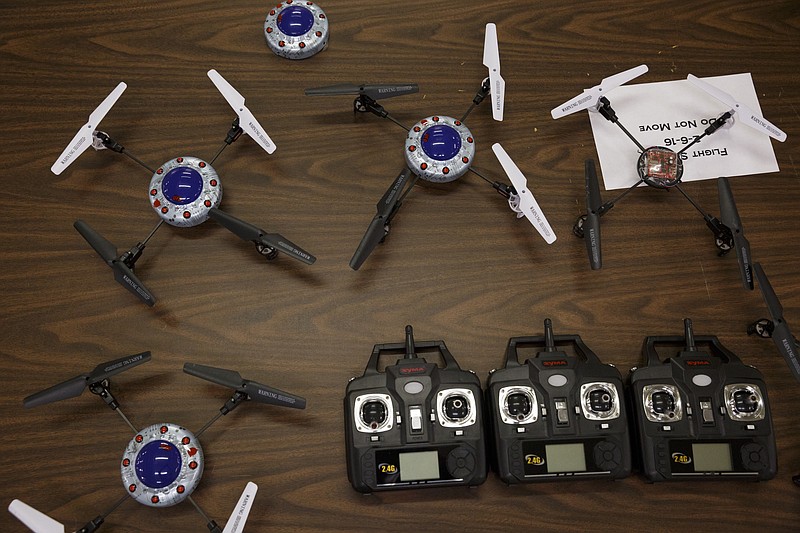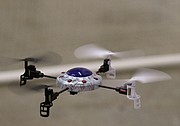Flight check
The Federal Aviation Administration’s Know Before You Fly campaign is designed to encourage safe operation of “unmanned aircraft systems,” including multi-rotor drones and other model aircraft. Flight restrictions include:* Follow community-based safety guidelines as developed by organizations such as the Academy of Model Aeronautics (AMA).* Fly no higher than 400 feet and remain below any surrounding obstacles when possible.* Keep your craft in eyesight at all times, and use an observer to assist if needed.* Remain well clear of and do not interfere with manned aircraft operations. You must see and avoid other aircraft and obstacles at all times.* Do not intentionally fly over unprotected persons or moving vehicles, and remain at least 25 feet away from individuals and vulnerable property.* Contact the airport or control tower before flying within five miles of an airport.* Fly no closer than two nautical miles from a heliport with a published instrument flight procedure.* Do not fly in adverse weather conditions such as in high winds or reduced visibility.* Do not fly under the influence of alcohol or drugs.* Ensure the operating environment is safe and that the operator is competent and proficient in the operation of the drone.* Do not fly near or over sensitive infrastructure or property such as power stations, water treatment facilities, correctional facilities, heavily traveled roadways, government facilities, etc.* Check and follow all local laws and ordinances before flying over private property.* Do not conduct surveillance or photograph persons in areas where there is an expectation of privacy without the individual’s permission.
Sign up
Want to learn to fly a drone? Free one-hour flight courses are available at the Chattanooga Public Library, 1001 Broad St., at 1 p.m. every Saturday through March 26. Each class covers the same curriculum. Register at chattlibrary.org/events/learn-fly-drone-registration-required.
Weighing just a handful of ounces and powered by four helicopter-like rotor blades, the Syma X1 drone is capable of alarming nimbleness.
Attempt anything more adventurous than a gentle nudge of the dual joysticks on its controller-transmitter, and the X1 - which is about as wide as a sheet of printer paper - will dart into the nearest solid object with the zeal of a suicidal, over-caffeinated hummingbird.
But with a price tag of less than $50 online, the X1 is inexpensive and surprisingly durable, which is why James Candan chose to use a handful of them to train would-be pilots during his ongoing drone flight school at the Chattanooga Public Library.
"It's something you can crash into a wall several times - which you will do - and pick it up and go again," the 33-year-old Candan says. "It's great for learning."
During the first of eight free weekly sessions on Feb. 6, more than a dozen would-be drone pilots assembled on the fourth floor of the library. There, Candan starts with an overview of various safety regulations before demonstrating basic controls using hand motions to mimic the joystick movements that dictate the aircraft's orientation, rotation, elevation and speed.
After that, the students split into groups, some heading to practice on a flight simulator using a bank of nearby laptops while the rest throttle up an actual Syma X1 inside a nearby netted enclosure that's about the size of a single-car garage.
"That is too fun," says Karla Rush, 60, while watching Candan deftly dipping and weaving the X1 within the enclosure while its motors emit a persistent whine.
Sporting wisdom suggests football is a game won by inches, but Candan admits the difference between flying a drone and crashing it requires the kind of focused precision that's measured in millimeters. Within seconds, he lets the drone drift too far to one side and its rotors tangle in the netting, leaving it dangling helplessly like a motorized, plastic fly in a giant spiderweb.
After freeing the propeller, Candan places the X1 on the floor in the center of the enclosure and hands Rush the bulky plastic controller.
"You just want to jump up," he tells her.
As Rush slowly pushes forward on the throttle, the X1 smoothly hovers to about eye level.
"Look at that control," Candan says, in awe. "Wow."
Looking equally surprised, Rush laughs.
"I'm just a hands-on type," she says. "I have to experience it to learn."
Rush and her husband, 62-year-old Tom, are older than many participants in the session, but the group ranges in age from Candan's 7-year-old daughter, Sophia, to 77-year-old Chattanoogan Ken Harrison, who says he is considering buying a camera-equipped drone to investigate late-night disturbances near his home.
"You can send it up and see, 'What was that noise next door?' or 'What is the dog barking at?'" Harrison says while waiting for Candan's orientation to begin. "I want to try it with these little ones first, though, before I invest in it.
"This class is probably bad for the drone companies. They're going to sell a lot less of them because fewer people will crash," he adds, laughing.
That anyone showed up to the session is a proof of concept for Candan, who proposed the idea of a flight school in response to the surging public interest in drones, more than 1 million of which were sold over the holidays, according to Federal Aviation Administration estimates.
Each of the library's Saturday courses - which continue through March 26 - offers a chance to ensure that a handful of potential pilots take to the skies in a way that is safe and reflects well on the drone community, Candan says.
"I was one of the people who didn't take lessons and just went out and learned to fly," he says. "Can a person learn on their own? Yeah, sure. Of course. Is everyone going to? Probably not.
"The more we make people aware these classes are available, the safer our community will be as more drone enthusiasts come to the surface."
Crowded airspace
Unmanned aerial vehicles (UAVs) have existed for decades - some remote-controlled craft were even used during World War II - but enthusiasts of modern-day, multi-rotor drones say the availability of mass-produced models and a steep drop in prices are making for much more crowded skies of late.
Thanks to their ability to self-stabilize for less-erratic flying and data connections that enable real-time, mid-air video feeds, drones are being used in a wide variety of industries, from monitoring wildlife populations and studying hurricane development to Amazon's prototype drone package-delivery service.
For 32-year-old Collegedale resident Ryan Harrell, the attraction of drones is the thrill of flying while wearing a video headset that streams the view from a camera attached to the aircraft. That way, he says, he can experience all the thrill of uninhibited flight at speeds of up to 90 mph without risking bodily harm.
"It's just the natural outflowing of the technology to get yourself into the craft," Harrell says. "[First-person piloting] allows you to do things you wouldn't necessarily do in a full-size aircraft, like flying between trees and doing flips and rolls that would take decades to learn to do in a full-size aircraft. It's definitely a rush."
An interactive media and creative design specialist at Southern Adventist University, Harrell is one of the founders of Greater Chattanooga Multirotor, a Facebook group for local drone pilots. When it started two years ago, the group originally served as an online forum for Harrell and a few of his student assistants and colleagues at the university. Since then, the group has ballooned to more than 65 members, including several from Knoxville and Atlanta. Candan also is a member.
Last fall, Harrell and other members of the group began dabbling in drone racing. During these aerial competitions, groups of pilots speed through a course - mostly on private property - designated by free-standing pylons and six-foot-tall "air gates," which must be flown around and through, respectively.
Combined with a first-person video feed, the heats look like something out of science fiction as drones pass over, under and around each other while executing turns and rolls with stomach-churning, acrobatic dexterity. Watching YouTube videos of first-person drone racing was ultimately what enticed Candan to purchase his first drone in late 2014.
"You would see your opponent bank a turn in front of you, and the light-up display on the back of their drone would light up your screen as they passed by," he recalls. "It seemed so reminiscent of pod racing or jumping on a speeder in 'Star Wars.' I wanted to freaking experience that for the first time.
"When I first took [my first-person-view drone] out dude, it's hard to explain. When you actually get up there, and you feel the exhilaration of lift-off and actually get control of it and bank your first turn. There's nothing else like it."
'Sport of the future'
Candan is so enthused with racing, he introduces the concept to his first flight school class before saying one word about altitude and line-of-sight flight requirements or the FAA's newly minted mandatory drone registry for all unmanned vehicles weighing between 0.55 and 55 pounds.
The flight school session kicks off with a promotional highlight reel for the Drone Racing League. The minute-long video is chock full of dramatic shots of drones speeding through neon-lit arenas and abandoned industrial works while quotes declaring drone racing to be "the sport of the future" (from Tech Times) and its pilots as "the next sports heroes" (from CNBC) fill the screen.
Candan has a vested interest in drumming up excitement about drone racing. The flight tutorials at the library are testing the water for Flyght Zone, an indoor drone racetrack he hopes to open in Chattanooga within a year. If he's successful, he says, guests will don headgear equipped with screens showing the drones' point of views and fly through an obstacle-filled course.
Everyone dreams of flying, Candan says, but drones are finally making it possible.
"I mean, what kid hasn't thought about having a device that they can control and fly themselves and see from that perspective?" he says. "I thought about it as a kid, and now that it's actually here, it's pretty phenomenal."
Contact Casey Phillips at cphillips@timesfreepress.com or 423-757-6205. Follow him on Twitter at @PhillipsCTFP.

